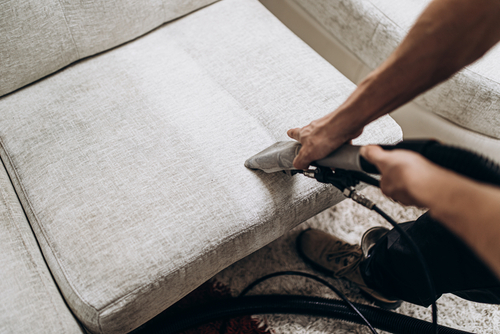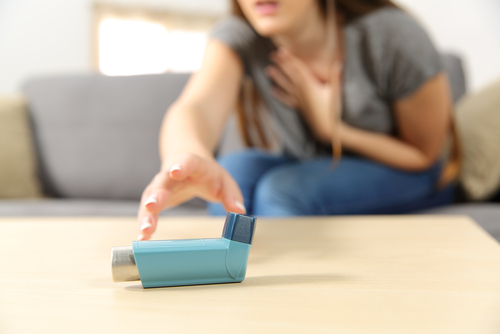
How to Remove Pet Hair and Lint from Carpets?
July 31, 2023
Upholstery Maintenance Tips 101
August 29, 2023The Role of Carpet Cleaning in Reducing Asthma Triggers

The Role of Carpet Cleaning in Reducing Asthma Triggers
The Role of Carpet Cleaning in Reducing Asthma Triggers. Asthma is a chronic lung condition that inflames and narrows the airways, leading to wheezing, shortness of breath, and coughing.
Environmental factors can trigger it, including allergens like dust mites, pet dander, and pollen.
Indoor air quality plays a significant role in managing and controlling asthma. Poor air quality can contain a higher concentration of asthma triggers, worsening symptoms and increasing the frequency of asthma attacks.
Due to their fibrous nature, carpets can trap allergens and contribute to poor indoor air quality, exacerbating asthma symptoms.
This article will explore how regular carpet cleaning can help reduce asthma triggers and manage asthma symptoms.
The Relationship Between Carpets and Asthma
Dust Mites, Pet Dander, and Pollen Accumulation
Carpets can act as reservoirs for dust mites, pet dander, and pollen, all common asthma triggers. These allergens can become airborne during daily activities, leading to respiratory issues for asthma sufferers.
Carpet fibers can effectively trap allergens, making them difficult to remove. These trapped allergens can contribute to prolonged exposure, worsening asthma symptoms over time.
Volatile Organic Compounds (VOCs) and Asthma
VOCs are chemicals that can be released into the air from everyday household products, including carpets. New carpets and carpets with certain types of cleaning agents or stain protectors can off-gas VOCs.
Exposure to VOCs can irritate the airways and trigger asthma symptoms. People with asthma are often more sensitive to the effects of VOCs than those without the condition.
Regular Carpet Cleaning for Asthma Management

The Importance of Frequent Vacuuming
- Using HEPA Filters for Effective Dust Removal
High-efficiency particulate air (HEPA) filters can trap small particles, including allergens like dust mites and pollen. Regular vacuuming with a HEPA filter can effectively reduce allergen levels in your carpet.
- Vacuuming Techniques for Maximum Allergen Extraction
It’s important to use the right vacuuming technique to remove allergens effectively. Slow, repetitive movements in all directions can help remove more allergens.
Steam Cleaning for Deep Allergen Removal
Steam cleaning uses hot water to penetrate carpet fibers and remove allergens. The high temperature can kill dust mites, while the water and cleaning solution can wash away allergens.
Professional steam cleaning services have the knowledge and equipment to deep clean your carpets. They can effectively remove allergens and improve the indoor air quality in your home.
Using Allergen-Reducing Cleaning Agents
Allergen-Friendly Cleaning Solutions
When selecting cleaning products, choose non-toxic and low-VOC options to reduce the release of harmful chemicals.
Simple household items like vinegar and baking soda can be used to create safe DIY cleaning solutions for allergy-prone individuals.
Precautions and Safety Measures
Always read labels and ingredient lists when buying cleaning products. Look out for chemicals that can trigger asthma or allergies.
Before using a cleaning product on your entire carpet, test it in a small area to ensure it won’t cause discoloration or damage.
Targeting Specific Asthma Triggers

Managing Dust Mites and Pet Dander
- Using Encasements for Dust Mite Protection
Encasements can prevent dust mites from infesting your carpets. They can be particularly useful in bedrooms where dust mite exposure is often highest.
- Pet Grooming and Cleaning for Pet Allergen Control
Regular pet grooming and cleaning can reduce the amount of pet dander in your home. Consider using a pet shampoo designed to reduce allergens.
- Reducing Mold and Mildew Growth
Dehumidifiers can reduce humidity levels in your home, making it harder for mold and mildew to grow. They can be particularly helpful in damp or humid climates.
Maintaining Indoor Air Quality
Improving Air Circulation and Ventilation
Air purifiers can reduce the number of allergens in the air, improving indoor air quality and helping to manage asthma symptoms.
Whenever possible, open windows and doors to increase ventilation and reduce indoor allergen levels.
Regular Carpet Maintenance for Allergy Prevention
A regular cleaning schedule can help keep allergen levels under control. Consider vacuuming daily and having your carpets professionally cleaned every 6 to 12 months.
Teach family members about the importance of keeping your home clean and free of allergens. This might include not wearing shoes in the house or washing hands after petting animals.
Seeking Professional Carpet Cleaning

When to Opt for Professional Carpet Cleaning
If you have severe asthma or are struggling to control allergen levels in your home, you may want to consider professional carpet cleaning. This can be particularly beneficial during peak allergy seasons.
Deep Cleaning for Stubborn Allergens
Professional cleaners can deep clean your carpets, removing stubborn allergens that home cleaning methods may miss.
Additional Allergy-Reducing Tips
Implementing No-Shoes Policies in Indoor Areas
A no-shoes policy can help prevent dirt and allergens from being tracked into your home from outside.
Provide shoe storage near the entrance of your home for guests to leave their shoes. This can help keep allergens from spreading throughout your home.
Choosing Allergy-Friendly Carpet Materials
Selecting Low-Pile and Hypoallergenic Carpets
Low-pile carpets trap fewer allergens than high-pile carpets and are easier to clean. Hypoallergenic carpets are also available and can be a good option for individuals with asthma.
Exploring Alternative Flooring Options
If carpets continue to be a source of asthma triggers, consider alternative flooring options like hardwood or tile.
Frequently Asked Questions (FAQs)

Can Carpets Aggravate Asthma Symptoms?
Yes, carpets can trap allergens like dust mites, pet dander, and pollen, which can aggravate asthma symptoms.
How Often Should Carpets Be Professionally Cleaned for Asthma Management?
It’s generally recommended to have carpets professionally cleaned every 6 to 12 months to maintain indoor air quality.
What Type of Vacuum Cleaner is Best for Allergies?
Vacuum cleaners with HEPA filters most effectively remove small allergens from carpets.
Are Natural Cleaning Agents Effective in Reducing Asthma Triggers?
Natural cleaning agents like vinegar and baking soda can effectively remove allergens without releasing harmful chemicals.
The Role of Carpet Cleaning in Reducing Asthma Triggers – Conclusion

Carpet cleaning is a powerful tool in asthma management. Reducing allergen levels in your carpets can improve indoor air quality and reduce asthma symptoms.
Regular carpet cleaning can create a healthier environment for individuals with asthma. By removing asthma triggers, you can make your home a more comfortable place to live.
Regular home and professional carpet cleaning services can help manage asthma symptoms by maintaining indoor air quality. Don’t let asthma control your life. Take control by keeping your carpets clean and allergen-free.
Take action today by implementing these carpet cleaning strategies. Contact us today to learn more about how we can help manage your asthma symptoms!



